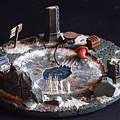|
Ice Pond
(Click thumbnails for
larger images) |
|
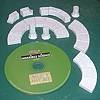 |
Materials:
HA Ruined Tower mould pieces
Snow Flock & Autumn
Leaves
CD
PVA / White Glue
Superglue
Basswood
Acetate & Blister Packs |
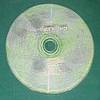 |
Stage 1
Roughen up the surface of the CD. I used
a coarse grade sandpaper to do this, but a lot of scoring with a sharp
knife will achieve a similar result. This provides a key for the glue to
adhere to - if you leave it dead smooth, there is a tendency for things
to peel off. |
 |
Stage 2
Take each of the floor tiles, and sand
the back to make them sit unevenly on the CD. This gives the illusion
that they have sunk into the ground over time. Break a few tiles, and do
the same to the separate pieces. |
|
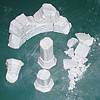 |
Stage 3
Glue the pillar halves together, and let
them dry thoroughly before "ruining" them. I did this using the back (blunt) edge
of a kitchen knife, striking the blocks with a firm, sharp blow. This
should give you a nice clean break.
Save the pieces of "rubble". |
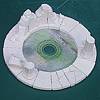 |
Stage 4
Glue the floor tiles to the CD using PVA
- they should still be pretty neatly arranged, but not perfect. Once you
are happy, stick the walls and pillars on top. Add some of the larger
bits of rubble around the broken walls & pillars, and leave the model to
dry. |
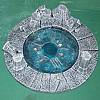 |
Stage 5
(sorry for the poor picture)
Paint all the stone work. Cut a circle of
acetate sheet to fit the central hole, and paint it in a watery colour.
Cut the same shape from some thicker blister pack material, and add
scratches to both sides with sandpaper and a knife. Cut the fishing-hole
in the centre and cracks running away from it. |
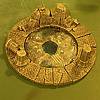 |
Stage 6
Fix the acetate pieces into position
using PVA. Add a few autumn leaves to the ice, and cover
them liberally with acrylic gloss varnish to seal them in. I also added
a "dirty" wash to the stonework as I thought it looked too new. |
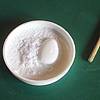 |
Stage 7
Place some of the snow flock
in a suitable shallow mixing container. Add a roughly equal amount of
PVA and the same again of water.
The flock material is very absorbent. |
 |
Stage 8
Mix the flock/water/glue thoroughly to
form a paste. It should slowly run to form a raised puddle - if it stays
in a lump, you need to add another drop or two of water to the mixture. |
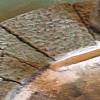 |
Stage 9
Using a cocktail stick or toothpick,
apply the mixture to the areas of the model where you want the snow to
be. I started by filling the edges of the pond, where there were small
gaps between the blocks and the acetate. |
 |
Stage 10
As the snow mixture dries, a couple of
things will happen. Firstly it will shrink down somewhat, and secondly
it will become more transparent, so you will probably want to add a
second layer in certain places. |
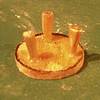 |
Stage 11
(sorry for the poor picture)
I wanted a stool to show where the
fisherman had been sitting. I cut a small circle of basswood, and
drilled 3 small holes into it. I then glued the pointed ends of cocktail
sticks into the holes before trimming the legs to size. |
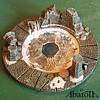 |
Stage 12
I added more snow, and then fixed the
stool into position. The footprints were made using a puddle of the snow
paste on a spare piece of acetate. Remove footprint shapes using a clean
cocktail stick whilst the paste is wet, and
simply peel it off once it is dry. |
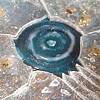 |
Stage 13
Cut some of the blister pack material to
make some tiny broken pieces of ice, and scatter them around the hole.
Add some ripples to the water using neat acrylic varnish. Once dry, add
a few bits of broken ice to the water. |
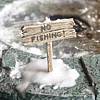 |
Stage 14
Cut a sign from basswood. Paint it and
leave it to dry. Drill a small hole in one of the floor tiles to accept
the signpost, and glue it into position. Add some snow paste around the
base of the sign to cover the hole, and a little on the top. |
 |
The (almost) finished model. I still have
a few more details to add, before the story is complete....
|
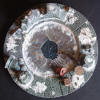 |
Stage 15
Final details added - a tackle box, fishing rod made from
plastic rod, and the hat of the unfortunate victim made from greenstuff. |
 |
Left View
The complete
diorama seen from the left side. This shot shows the finishing touches. |
 |
Front View
The complete
diorama seen from the front, with the claw marks in the ice clearly
visible. |
 |
Right View
The complete
diorama seen from the right side, showing the sign. |
 |
Rear View
The complete
diorama seen from the back. |
|
The BLT (Bloody Large
Telescope)
(Click thumbnails for
larger images) |
|
I was challenged to make an observatory model, and thought I would start
by building the telescope. You can probably tell that I was very much
creating this on the fly, with no real plans, just a vague idea of how
large I wanted it to be. As I created the model, I allowed the various
pieces to "talk to me" - gaining inspiration from the details of the
mouldings as to possible functions etc. Thus the model grew over the
space of a few days in a very organic way. I have never made such a
complex model in this manner before, but I did find it rewarding and
very different from the meticulous planning I would usually do. It is
also my first attempt at a steam-punk style piece. I hope you enjoy it
as much as I did. |
|
|
Materials & Tools:
Craft Knife
Razor Saw or Hacksaw
Wire Cutters
Hot Glue Gun
Superglue
5 Minute Epoxy Glue
Paint and Brushes
Pin vice
the photos are annotated showing the materials used |
 |
Stage 1
Prepare the
pieces shown and stick them together with superglue. |
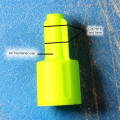 |
Stage 2
Cut an
air-freshener cap into three sections with the razor saw, or hacksaw. |
 |
Stage 3
Superglue the
half-washers either side of the nub of cocktail stick in the bead. Try
to get it to stand up vertically. |
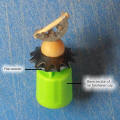 |
Stage 4
Hot glue the
assembled piece to the bottom section of the air-freshener cap. |
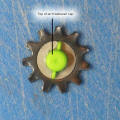 |
Stage 5
Superglue the
top section of the air-freshener cap to the centre of the flat non-slip
washer piece. |
 |
Stage 6
Superglue the
washer to the base of the air-freshener cap, interlocking the teeth to
resemble cog-wheels. |
 |
Stage 7
Hot glue a
sports bottle cap to the base of the air-freshener cap. Superglue some
rhinestones and plastic pieces in place to add visual interest. |
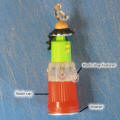 |
Stage 8
Next, hot glue
a third bottle cap to the base of the assembly, and a metal washer to
the base of that to improve stability. Add a plastic snap-fastener as a
control valve, using superglue. |
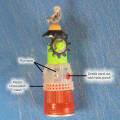 |
Stage 9
Next,
superglue some short lengths of thin wire above the rhinestones and
through the holes in the cap. Cut a circle from plastic (an old credit
card works well) and superglue into place.
Wrap plastic cross-stitch mesh around the top of the
lowest cap to conceal the joint. Tie it tight with 3amp fuse-wire before
securing it with superglue. |
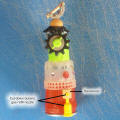 |
Stage 10
The yellow
parts are an adapter nozzle from a can of butane gas, such as those used
to refill lighters. Trim one side flat, and trim the top to a suitable
height before attaching with superglue.
Add a small block of basswood or balsa using hot glue,
and attach some plastic "controls". I used the piece trimmed from the
top of the nozzle. |
 |
Stage 11
Spray paint
the whole assembly with matt black primer - "black bomb". |
 |
Stage 12
At this point I was "listening to the model" again -
trying to decide how best to paint things to make them look functional.
I started with bronze for most of the base, and a bluish silver for the
gears.
|
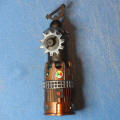 |
Stage 13
The nozzle was
definitely a copper steam inlet, with controls above it and the circle
then made sense as a pressure gauge. |
 |
Stage 14
I added a tiny
plastic circle on the control box, and painted it green. I also painted
a glowing green band around the middle and base coated the sphere at the
top in a mix of light brown and gold. |
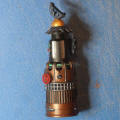 |
Stage 15
A neat gold
layer was then added, and the snap fastener painted in red. I painted
the hollows in the air-freshener cap in a pewter colour, then
highlighted with silver. |
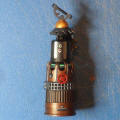 |
Stage 16
Finally, I
painted the two tiny knobs in green and red, with white surrounds.
OK - that's the mount finished - now the telescope
itself. |
|
|
 |
Stage 1
Cut four
decreasing diameters of Plastruct plastic tubing to about 1" lengths,
then assemble with superglue. Cut some electrical insulation tape into
thin strips, and wrap around the tubing in places until you get the
desired thickness.
|
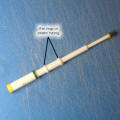 |
Stage 2
Add a couple
of thin bands of the plastic tubing where the mount will attach to the
telescope. I also added a thin slice to the largest part, and filled it
with glue to resemble a maker's plaque. |
 |
Stage 3
The sighter
scope is another of the adapter nozzles from a butane can with a section
of round sprue glued to the end, with more insulation tape strips.
Drill two small holes with the pin vice and attach the
sighter scope to the main telescope - I used some spare plastic parts,
but wire would work too. |
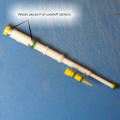 |
Stage 4
If you craft
greetings cards, you may have used sheets of peel-off stickers. There is
always a lot of wasted sticker left on these surrounding the actual
words or icons. I cut a couple of thin strips from the waste sections
and stuck them around the top of the scope to add some visual interest. |
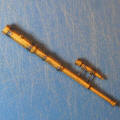 |
Stage 5
Spray with
matt black primer, then paint. I went for a brassy look for the barrels
of the two scopes, with bands of pewter highlighted in silver. |
 |
Top tip: to
get good coverage of metallic paint over large areas, first apply an
undercoat of a similar non-metallic colour with a little of the metallic
paint mixed in - browns for gold and copper, and greys for pewter and
silver.
Note that I
forgot this step - hence the gold paint is a bit patchy in places. |
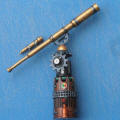 |
Stage 6
Mix a tiny amount of 5 minute epoxy resin and attach the
telescope to the mount. Hot glue will work, but the joint won't be as
strong or as neat.
Here's the finished model from the side with the
pressure gauge.
|
 |
... and a view
from the opposite side. |
|
|
